B2B video marketing offers a lot of opportunity to grow your tech, industrial, or professional service business, with 59% of executives stating they would rather watch a video than read text - such as on a downloadable eBook.
This is not something you want to miss out on, and you should get started as soon as possible. But how do you execute this successfully? Whether you want to improve your existing video strategy or you’re brand new to the idea of utilising B2B video marketing at all, don’t fret!
This comprehensive guide will help you to understand what B2B video marketing is all about, what types of video you should create, how to promote your video, and the steps you need to take to maximise the ROI (return of investment) on your B2B video marketing.
From this guide, you will learn how to use video to:
- Help you create a digestible, and accessible version of your brand
- Attract potential customers throughout the buyer journey of awareness, consideration, decision
- Generate more leads from your website
- Increase the sales of your product or service
But how can you make this a reality? Continue reading to find out.
What is B2B video marketing and why should you do it?
So, what exactly is B2B video marketing?
B2B video marketing is defined as a component of a marketing strategy that involves planning, developing, and publishing content in the format of video.
While video may traditionally be seen mostly as an appropriate marketing tool for B2C businesses, this is no longer the case, as B2B companies are realising the great value that video marketing can bring to their campaigns.
Making great videos alone isn’t a one-way ticket to marketing success, but is in fact just one component that should complement everything else you’re doing. Defining your video strategy and ensuring that it weaves seamlessly into your other marketing channels is the most important aspect of getting started with B2B video marketing.
According to research, viewers retain 95% of a message when it is delivered via a video compared to just 10% when reading text - so why wouldn’t you opt for video? Creating content that is helpful, high-quality, and crystal clear should be your top priority, and opting out of using video altogether is no longer an option. Let the numbers speak for themselves on why you should start investing in video within your marketing campaigns...
- 68% of people will watch a full video if it’s a minute long or less
- 89% of video marketers say video gives them a good ROI
- 69% of marketers expect the top content marketing-related area of investment for 2022 to be video
- 81% of businesses are now using video for marketing
- 97% of marketers claim that videos help customers understand products
To put it simply, there are so many benefits to utilising video within your content strategy that you just can’t afford to miss out on. Video is an opportunity to humanise your business, put a face to the brand, and can offer personalisation that other types of content cannot.
- Maximise your SEO rankings
- Help your customers understand your products or services
- Increase engagement across multiple channels
- Help your customers in making a purchasing decision
- And, of course, your competitors are likely using video too!
Strategy and planning
Now, you might be quite keen to get started with preparing your video project. But before you jump in, you need to understand what you are trying to achieve and how your video fits into the overall content strategy. Video is a useful, versatile tool throughout every step of the marketing funnel - not just the first stage of increasing brand awareness. Your video content, if executed successfully, will ideally fit right into your existing content plan and will reach potential customers at all stages of the buyer journey.
A B2B video marketing strategy is not a one-way ticket to marketing success, but is in fact just one component that should complement everything else you’re doing strategy-wise. Defining your video strategy and ensuring that it weaves seamlessly into your other marketing channels is the most important aspect of getting to grips with B2B video marketing.
Personas
Prior to beginning the pre-production planning stage, you should also establish who you are making videos for. It’s best practice to start by building buyer personas.
These semi-fictional representations of your would-be customers allow you to create video content that directly addresses your audience’s pain points and issues, offering your product or service as the solution.
Through framing your content’s messaging around these personas, your customers’ information needs will be met as well as any SMART goals you may have set yourself.
It’s a good idea to begin by thinking about how you can use video at each stage of the customer journey.
No matter the platform your video is found on, whether via social media, organic traffic, or advertising, it will be informed by the type of content you are producing and where in the buyer journey it relates to.
At the first stage, for example, video can be used to introduce your business and help people to understand their pain points and challenges. The consideration stage then offers potential solutions to these challenges, and the decision stage is where the buyer decides on who they’ll be working with.
No matter how much experience you have with video, your goal should be to move the customer along the sales funnel by meeting their content needs and having calls-to-action as the driving force behind this.
A note on accessibility:
One thing you should consider vital when thinking about who is interacting with your content is whether or not your video content is accessible to everyone.
Shooting, editing, and uploading your video is all well and good, but have you considered implementing features that make your video able to reach people of all abilities? There are 14.1 million people living in the UK with a disability, and you want to make sure your content is as accessible as can be for every possible viewer.
You should consider:
-
Audio and visual alternatives, i.e. closed captions, transcripts, accessible colour choices
-
Text size, font, readability, complexity
-
Animations that abide by WCAG guidelines
Types of videos to consider
There is a huge variety of video types to choose from, and they all serve different purposes. Having a good grasp of the video you’re producing can do wonders for your overall marketing campaign, in the pre-production stage, production, and with the final product.
- Product videos (decision stage): This type of video is perfect for showing off a specific product or service and generally gives a brief demonstration of the feature.
- Explainer videos/How to (awareness stage): The aim is to teach your audience something they didn't know prior to viewing, which could be by showing a specific function of the product.
- Behind the scenes (BTS) (decision stage): This video format is a great way to give a face to your brand. It is a perfect tool for social sharing as it gives the customer a look behind the curtain of your company
- Talking head video (awareness, consideration, and decision stage): This format usually consists of one talking point and uses a single person, and can instantly bring life to your accompanying product.
- Case study (decision stage): This type of video gives you an opportunity to tell a compelling story about your product. You can go beyond the customer’s own experience and talk about your product’s benefits in greater detail.
- Brand videos (decision stage): This type of video would appear on your homepage, showing every visitor exactly who you and your business are
- Teasers (awareness, consideration, and decision stage): This could be teasing something like a blog post, to something as big as an event you’re planning.
- Social media video post (awareness, consideration, and decision stage): A social media video is a small insight into what your business is up to, whether it’s on your own website or a social media platform.
- Tutorials (decision stage): Tutorials are intended to talk the viewer through a step-by-step process and are an amazing way to show that you have your customers’ best interest at heart.
- Expert interview (awareness, consideration, and decision stage): An expert interview is what it says on the tin, an interview with an expert. This is a great way to show knowledge and professionalism in a particular niche.
- Recruitment: This sort of video is used to advertise a job opportunity within your company. Studies have shown that job postings with video get 12% more views, and result in 34% more applications.
- Webinars (awareness, consideration, and decision stage): It’s a great idea to record your business’s webinars, as they can be turned into a great resource of information for your website.
- Event videos (decision stage): Event videos give the viewer an insight into your business, showcasing an event you’re hosting in the near future.
- Customer testimonials (decision stage): A first-hand account of a customer’s experience with your company and product or service, a customer testimonial video is a powerful tool.
- VideoAsk (awareness, consideration, and decision stage): VideoAsks are a video-based interactive chatbot. They're one of our favourite tools at Axon Garside due to the personalisation they offer which is key to an inbound approach - we think they should be a lot more popular than they are right now.
Pre-production
Once you have decided what type of video you want to create, it’s time to enter the pre-production stage. Whether you choose to produce your video in-house or work with a videographer, there is a multitude of things you need to consider before the lights, camera, and action.
Things you need to consider during the planning phase:
- What are you aiming to achieve with your video?
- What is your budget?
- Do you have the right equipment ready and available?
- How long is the video going to be?
- Is it a scripted or non-scripted video?
- Is the video subject prepared to be filmed?
- Where will this video be filmed?
- Where will your video be posted?
- When is the deadline?
Storyboarding
Storyboarding can be a really in-depth process in the film industry, but for the types of videos a B2B business would create, it can be a reasonably quick and easy process. Whether your video requires basic notes to guide your speaker, or you need a more complex shot-by-shot plan, it’s important to plan well so your final cut is suitable for your customer base. You will also want to consider the following:
- The background of your shot
- Whether you want to use any B-roll footage
- Any animation you’d like to include
- For background music, it’s advised that you opt for copyright-free songs
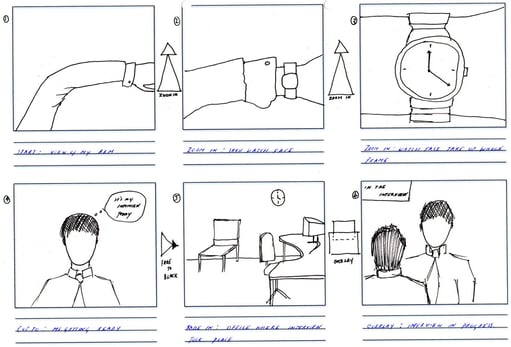
Production
All planned and prepared, it’s now time for you to start filming. But first, let’s take a look at a few elements you need to think about while producing your video…
Camera settings
The homemade feel of an iPhone-shot video can definitely be effective, but given the option, is that how you want to present your brand and business? A higher-quality DSLR camera will provide you with a crisp and professional image, but you may require a videographer who really understands how this equipment works to get the best possible result.
Location
You may have already chosen your filming location during the planning phase of your B2B video marketing journey, but wherever you’re going to be filming, you’ll need to prepare the foreground and background of your shot. No matter the type of video you’re creating, it’s advised that you avoid any distractions being included in the shot and take into account the rule of thirds.
Lighting and sound
The lighting and sound included in your video can directly affect the overall quality of the final product. While some aspects can be edited in post-production, it’s helpful to consider these things while filming to save time and money from editing time.
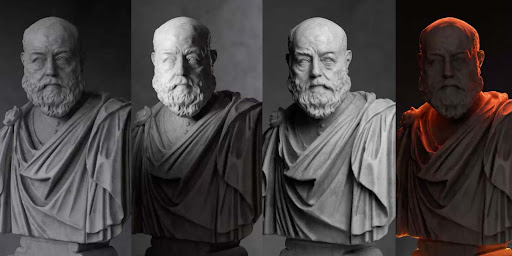
Shoot your shot and take your time
It can definitely be overwhelming to shoot your own video from start to finish, but with these tips, you will be well-equipped to produce a video you are proud to show off. Remember, overshoot! The more footage you have at hand, the better your finalised video will be.
It’s now time to rewatch your footage until you can’t anymore! Reviewing and refining your footage is key to creating a video you and your company will be proud of.
Editing your video
While you may have planned the length of your video in the pre-production stage, the editing process is where you come to the final length of your video following trimming. Following this, your video will start to take shape as the final cut.
You can also completely change the feel and tone of your video through simple edits such as music and colour grading. Make sure the music matches your video’s message, and ensure that you can easily hear any speech over the music and your speaker isn’t drowned out. Colour grading can be compared to applying a filter over a photo, and can completely change the tone and bring life to your video!
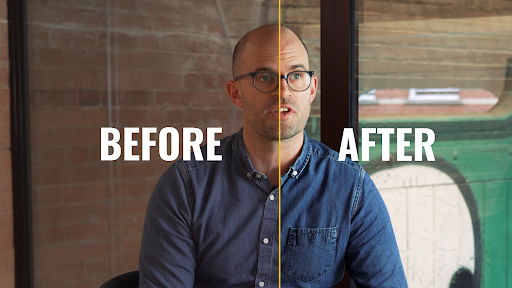
The use of graphics, animations, and on-screen text can enhance the visual appeal of your video even further by highlighting particular points and engaging your audience. Once multiple members of your team have reviewed your video, and final amendments have been made, you’re ready to premiere your video!
Audience creation
Now your video is ready for action, you need to consider how it will be found by your target audience. There will be a lot of competition for views on any video platform, but to help you out we’ve compiled a list of tips and tricks you can use to get your video out there so you can maximise lead generation and ROI (return on investment). With Cisco predicting that over 80% of all internet traffic will consist of video by the end of 2021, it’s essential that you optimise your video for social media, search engines, and other platforms - such as HubSpot Video and Vidyard - to reach your full potential.
The platform your video is posted on will affect how well your content is received, depending on if it reaches your target audience or not. YouTube is a given, as not only is it free, but it is massive, with 26.1 billion videos uploaded onto the platform in 2020 alone. In terms of social media, LinkedIn and Facebook have both shown that video is preferred, with videos on LinkedIn earning an average of 3 times the engagement of text posts.
Here at Axon Garside, we’re a HubSpot Diamond partner, so HubSpot Video is our best friend. Used to “create, host, manage, customize, and measure video” all on one integrated platform, this tool can be utilised and elevated across the whole of your business, so shouldn’t be taken lightly. Vidyard, on the other hand, is another great platform that allows you to nurture your leads and delight your customers specifically using video.
Shoot your shot and take your time
As well as being conscious of the platform you choose to upload your video onto, you should also take into account when people are more likely to watch your video. By analysing data collected via Google Analytics, or site-specific insights like Twitter Analytics, you can see when the best time to post your video is, thus maximising your views and engagement.
Optimising your video for keywords is the foundation of a great SEO (search engine optimisation) strategy, and this is a stone that should definitely not go unturned. SEO increases the likelihood of your content appearing in search results, and keyword research tools like Ahrefs should be used to see the most popular keywords that you should target in your video’s transcript, tags, and title. If you want to find out more about the world of SEO, we have a handy beginner's guide on optimising content and conducting keyword research.
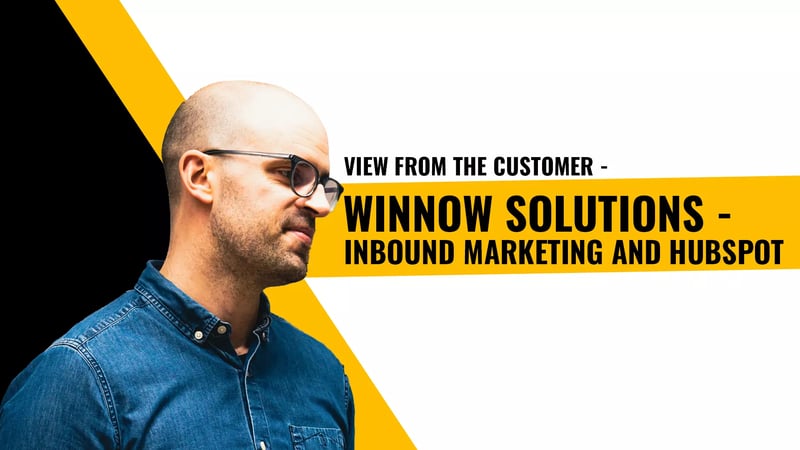
Your thumbnail is also important to search engines, so don’t forget to ensure the thumbnail text matches the video title and catches the attention of viewers. When creating your thumbnail, Google recommends that they are:
1280 x 720 pixels in resolution (with a minimum width of 640 pixels)Uploaded in the appropriate image formats (JPG, GIF, or PNG)
Under the 2MB limit
In a 16:9 aspect ratio
Optimising and measuring the success of your videos
So you’ve done the hard work - but how can you make a return on your investment and make the most out of your videos? You’ve come to the right place...
You can easily make the most of your footage by repurposing it by making slight changes. For example, chopping up footage or removing the music can transform your video into another type, such as a preview video or social media post. Not knowing how to recycle footage can be detrimental to your marketing campaigns, and following this advice will ensure you get ROI from your videos to the maximum capacity.
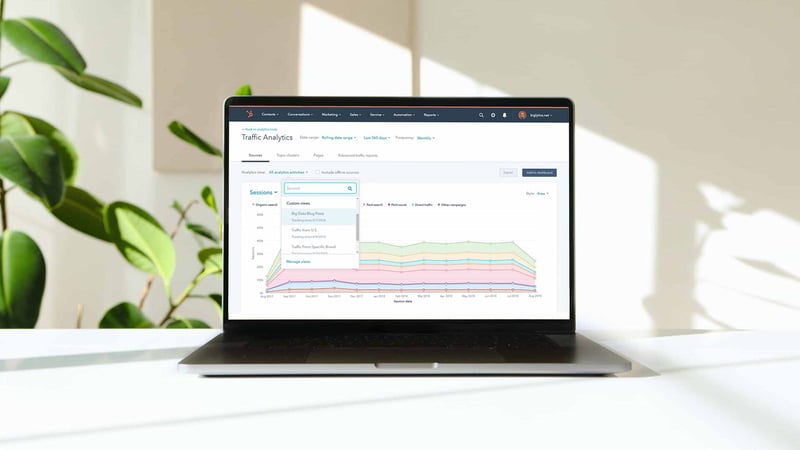
To keep on top of your video content and ensure you don’t post the same content in close succession, it’s a great idea to create a spreadsheet that logs when and where you last posted a video. Not only does this avoid repetition, but also helps you track how well your video content has performed and whether it may need updating.
To measure the success of your videos, we’d recommend first working out what success looks like to you and your business. The metrics that you use to measure your video success will differ depending on your SMART goals that you (hopefully) established prior to posting your content. SMART stands for specific, measurable, attainable, realistic and timely. If you didn’t do this yet, don’t worry, it’s not too late. Below, we’ve listed a few examples of the metrics you may want to consider using to gauge your video’s success.
- Views
- Play rate
- Social media shares
- CTR (click-through rate)
- Conversion rate
Should I do this in-house or via an external agency?
In-house might seem like a good idea, but there’s a large scope for things to go wrong compared to hiring an external agency. Outsourcing a videographer may seem like a big investment for your business, but you receive insights that are truly invaluable. Ultimately, going through an external agency will give you access to someone who can aid you every step of the video process, as well as give you access to their equipment and expertise.
Not only this, but an external agency will have the knowledge and experience of aligning their B2B video marketing plan with the rest of their content strategy. This, paired with stunning video production, guarantees an engaged audience and progression through the buyer journey.




.jpg?width=800&name=pexels-canva-studio-3194519-(1).jpg)



.png?width=115&height=183&name=sade%201%20(1).png)